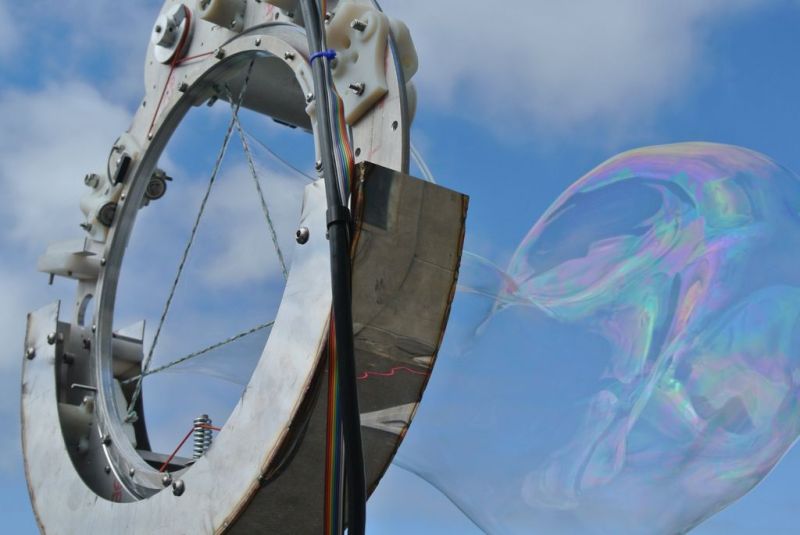[GordonKirkwood] needs soap bubbles. Big soap bubbles. Why does he need soap bubbles? Because – soap bubbles!
Actually, [Gordon] is a photographer, and he wants to capture candid moments and fleeting expressions. What better way to inspire wonder and amazement than to be able to produce a giant soap bubble on demand? And what better way to do it than with an intricate, computer controlled giant bubble machine?
[Gordon’s] inspiration for the bubble producing mechanism comes from the end effector of the Canadarm robotic Space Shuttle arm, which used a cable-grapple design to snare and secure payloads. [Gordon] uses a similar principle to interweave bubble juice-soaked strings and pull them apart in a plane to form a soap film. A puff of wind or a quick shot from a fan inflates and launches the bubble, which the mechanism can pinch off for precise control of size.
The amount of work [Gordon] put into the machine is impressive. His Instructables post is incredibly detailed and goes into not only his build but also his design process and prototyping, the science of soap bubble instruments, and even a nod to the work of other pioneering bubble enthusiasts. And he thoughtfully includes a recipe for professional-grade bubble juice, with a secret ingredient that may surprise you.
You say your bubble-producing needs run more toward quantity than quality? Try using the juice in this homemade bubble robot.
















Is that a stargate?
If that wasn’t the intended look they were going for I will be somewhat surprised.
Maybe they could blow bubbles with fast setting liquid rubber and use a vortex cannon to launch them out of the “iris” aperture. Catapult a payload inside just before it closes off and inflate them with some lighter than air gas and you have a weather balloon launcher.
Beat me to it. ;)
yes but the wormholes are not stable and their destinations are random -.-
Great mechanism! Looking for more information in how to make it, I found a very nicely made iris used in a door window. Maybe material for another article?
https://www.youtube.com/watch?v=-qlgsCU2NJo
Irises are truly beautiful mechanisms. Trying to articulate why they are so interesting is an interesting challenge, but I think that the radial symmetry of action, and the emergent quality of the aperture not singly dependent on any cable or leaf, but all of them, are the main elements of my appreciation of them. Here’s a motorized iris of a different sort, which I made.
https://www.youtube.com/watch?v=HOOoyHeOP8k
Well yea it’s nice and all but everybody does round bubbles, how about some octagonal bubbles, or rectangular or square?
why stop at 3 dimensions?
https://www.artofmathematics.org/sites/default/files/media/images/bubbleforeshortenedhypercubeminimized.jpg
Because it’s witch craft that’s why… (You don’t want to envoke the purple smoke.)
“..a secret ingrediant that may suprise you”
And You Won’t Believe What Happens Next!
:-/
Where’s the link!?
Its in the writeup above (the Instructables page)
Spoiler. sex lube. However I would recommend reading it, was quite interesting.
http://www.instructables.com/id/CNC-bubble-machine
Hi Guys- I’m the maker:-) the resemblance of the movie “Stargate”‘s namesake prop to my real mechanism is pretty uncanny, especially considering that it DOES have a shimmering fluid membrane in it’s middle, through which interesting things (if not other sides of the universe) can be glimpsed. However, my design looks the way it does because of real functional constraints and considerations – not any emulation of a movie prop. Irises are cool mechanisms in general though! Here’s one I made to launch smoke-rings: https://www.youtube.com/watch?v=pvgh_gN4BBk
I’d love to chat with you about this project. I reached out to you on your website.